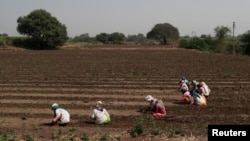Nearly a decade ago, farmers in India began growing a staple grain that was fortified with iron and zinc to address a longstanding health problem – anemia among women and children. Since 2018, its cultivation is also expanding in Africa.
Now millions of people consume the grain, helping ward off malnutrition that results, not only from how much people eat, but what they eat.
Pearl millet has long made up the bulk of diets of rural communities in drought-prone regions of India and Africa. But while the grain fills stomachs, it lacks crucial vitamins and minerals resulting in what is called “hidden hunger” among people who cannot afford balanced diets.
Mahalingam Govindaraj, an agricultural scientist based in Hyderabad city, told VOA it took nearly a decade of research to develop the biofortified pearl millet. He will be awarded the 2022 Norman E. Borlaug Award for Field Research and Application on October 19 by the World Food Prize Foundation for his “outstanding leadership in mainstreaming biofortified crops, particularly pearl millet, in India and Africa.”
Govindaraj is a senior scientist with Washington-based HarvestPlus, the Alliance of Biodiversity International, and The International Center for Tropical Agriculture, that have focused on fortifying staple crops with vitamins and minerals to address micronutrient deficiency.
The son of a farmer, Govindaraj was the first in his family to graduate from college and was excited to learn what impact science could have on agriculture. The biofortification of staple crops had emerged on the horizon and he began work on millets. “It was an emotional choice for me because before my father switched to rice, my family used to grow millets,” he recalled. “The idea is not to replace what is traditionally eaten, but to make it more nutritious.”
Packed With Iron
Pearl millet is a hardy grain grown widely in arid regions of India and Africa. Govindaraj’s farming background equipped him to know exactly what farmers would want. “We had to ensure that its maturity period should be short, it should be a high yielding variety and the grain color should be good, because otherwise they would not grow it,” he said.
Iron-enriched pearl millet seeds, called “Dhanashakti,” were first given to farmers in the western Indian state of Maharashtra. Initially, seed companies used vans with loudspeakers in villages to popularize it.
Now, about 120,000 Indian farmers grow the grain known as “bajra” across India’s central and southern regions. By 2024, an estimated nine million people will eat a traditional flatbread called “roti” made with this grain.
Its benefits: 200 grams of this grain provide women with about 80 percent of their recommended daily allowance of iron, thus providing a cheap source of the micronutrient in a country where nearly 60 percent of the children below five and over half the pregnant women are anemic.
In the last four years, farmers in the drought-prone areas of the Sahelian zone of West Africa in countries like Niger and Senegal have also begin growing iron biofortified pearl millet known as “Chakti.”
“Biofortification is gaining momentum because it can ensure better nutrition to the coming generation and is cost effective,” points out Monika Garg at the National Agri-Food Biotechnology Institute in Mohali, India. “If nutrients are added to the crop itself, it reaches the masses easily and is cheaper. While giving artificial supplements is possible, it is far harder to reach the rural poor with these interventions.”
Grain Addresses "Hidden Hunger"
The benefits of the fortified pearl millet are already evident. A study by Britain-based BMC Public Health in India’s Maharashtra state showed that a diet of iron-rich pearl millet given to a group of adolescents for six months reversed iron deficiency and also improved memory, attention and physical activity levels.
The scale of “hidden hunger” is huge – an estimated two billion people, or nearly one in four persons, suffer from vitamin and nutrient deficiencies, according to the World Health Organization.
Govindaraj points out that the benefits of biofortified crops were also highlighted during the COVID-19 pandemic when tens of thousands of people grappled with reduced food portions because they lost incomes. There are also concerns that climate change and food inflation as a result of the Ukraine conflict are exacerbating malnutrition.
In recent years biofortification of key food crops to tackle malnutrition has emerged firmly on the radar of India and many other developing countries.
In India, several government agricultural institutes are working on it. Besides pearl millet, crops such as wheat and rice have also been fortified with micronutrients.
The next challenge is to mainstream those biofortified crops by ensuring that all farmers plant seeds containing micronutrients. The Indian government has already stipulated minimum standards of zinc and iron that all varieties of pearl millet should contain.
“This is a major milestone,” says Govindaraj. “A beginning has been made and as its cultivation gets scaled up over the next five or six years, it will ensure that every person consuming pearl millet gets micronutrients along with their energy needs.”






